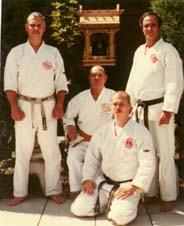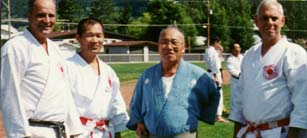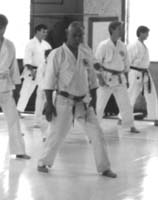On June 5, 1984, Doctor Chitose (O-Sensei) passed away. His son Yasuhiro Chitose was designated to take over the organization. The older black belts from Japan and around the world who had been so faithful to O-Sensei had been requested by Doctor Chitose Sensei to guide and advise the younger Chitose.
In November 1984 Dometrich Sensei was promoted to Lieutenant Colonel and Assistant Chief of Police of the Covington police department. On June 2, 1986 Dometrich Sensei retired from the police force. Later that year (September and October) Dometrich Sensei, Okusan, and twenty five students traveled to Japan for the "Soke Cup" International Chito-ryu Karate Tournament. After the tournament Dometrich Sensei, Okusan, and four other students traveled to Okinawa to visit friends while the rest of the United States contingent went sightseeing in Japan. While in Okinawa Mr. Takayoshi Nagamine and Dometrich Sensei visited O-Sensei’s eldest son who had been paralyzed twenty three years earlier in a car accident
On August 2, 1987, Dometrich Sensei once again entered the United States Army on an active duty status as a member of the 11th Special Forces Group Military Intelligence Company. He was fifty two years old at this time and worked as an Intelligence Analyst. His commitment to the military during this time meant less available time to actively contribute to the day-to-day business of the US Chito-kai.
He solved the management problem of the organization by establishing an Executive Committee. He appointed a President to function as the Chief Operations Officer, a Vice President, a Director of the Executive Committee responsible for holding monthly meetings, a Technical Director, and an Assistant Technical Director to assist with the training and technical standards.
 The Gulf War crisis came to the forefront of world news on August 2, 1990. This was the exact date Dometrich Sensei was to be released from active duty in the Army. He and thousands of others were notified on that day that their enlistment’s were extended. Because of the commitment of the United States Chito-kai to hold the 1992 Soke Cup, and not knowing if the war in Iraq would be short or long, Dometrich Sensei decided to send the Soke Cup Flag back to Japan. It was now February 1, 1991 - just before the ground war started. Many members of the U. S. Chito-ryu Karate Federation were also members of the armed forces reserves and had been recalled to active duty.
The Gulf War crisis came to the forefront of world news on August 2, 1990. This was the exact date Dometrich Sensei was to be released from active duty in the Army. He and thousands of others were notified on that day that their enlistment’s were extended. Because of the commitment of the United States Chito-kai to hold the 1992 Soke Cup, and not knowing if the war in Iraq would be short or long, Dometrich Sensei decided to send the Soke Cup Flag back to Japan. It was now February 1, 1991 - just before the ground war started. Many members of the U. S. Chito-ryu Karate Federation were also members of the armed forces reserves and had been recalled to active duty.
The United States had agreed to host the Soke cup in 1991, but with the unforeseen intrusion of the Gulf War, Dometrich Sensei felt the U. S. Chito-ryu Karate Federation might not be able to carry out its obligation adequately. Eighteen months remained until the scheduled Soke Cup. Relinquishing our opportunity to hold the tournament at this point in time ensured that the International Chito-kai had sufficient time to choose an alternate nation to organize and host the Soke Cup. A new nation was chosen by the International Federation - Australia. As it turned out the ground war lasted only 100 hours. The U. S. could have hosted the tournament after all, but the flag had been passed. It was better to have been safe than sorry in the event the war had taken a turn for the worst and had dragged on for months or even years. A very small group of U. S. Chito-kai students were able to make the trip to Australia for the tournament.
 O-Sensei’s son (Yasuhiro) traveled to Canada and the United States in August 1993. Yasuhiro was scheduled to appear at a U.S. sponsored clinic that summer. The original date set for the clinic had to be canceled because Yasuhiro had changed his schedule just two weeks before the agreed upon date. The large campground reserved (Camp Ernst) was lost, along with the money paid in advance. As a substitute, a small grade-school gymnasium was secured for the clinic. This clinic was only marginally successful. Yasuhiro Chitose was shown the facilities at Camp Ernst that had been paid for and lost because of his last minute change of dates. He agreed he would be in the U. S. on the scheduled date
without fail for the 1994 U. S. Summer camp.
O-Sensei’s son (Yasuhiro) traveled to Canada and the United States in August 1993. Yasuhiro was scheduled to appear at a U.S. sponsored clinic that summer. The original date set for the clinic had to be canceled because Yasuhiro had changed his schedule just two weeks before the agreed upon date. The large campground reserved (Camp Ernst) was lost, along with the money paid in advance. As a substitute, a small grade-school gymnasium was secured for the clinic. This clinic was only marginally successful. Yasuhiro Chitose was shown the facilities at Camp Ernst that had been paid for and lost because of his last minute change of dates. He agreed he would be in the U. S. on the scheduled date
without fail for the 1994 U. S. Summer camp.
The years between 1984 (O-Sensei’s death) and 1994 also saw some turmoil within the United States Chito-ryu Karate Federation. The majority of the problems arose over the Taikyoku kata of Dometrich Sensei versus the Kihon Dosa kata, which were favored by Yasuhiro Chitose. Several times Dometrich Sensei agreed to switch to the Japanese format of training beginners. Each time, after a trial basis of several months to a year, he would return to the Taikyoku kata. He felt they were more appropriate than the Japan Kihon Dosa as basic training for the U.S students who desired to compete in national and international tournaments.
In 1993/94 some U.S. students requested permission to travel to the Hombu in Japan and train. Their requests were granted with one condition: upon returning they were to ensure Dometrich Sensei and other ranking black belts were made aware of any changes and/or modifications to all techniques and kata prior to teaching the changes.
 On July 26, 1994, while teaching a class at the Hombu Dojo, Dometrich Sensei noticed that some of the students were not doing the techniques as he had taught them. He was advised by one of the members who had just returned from Japan that "this was the way they were now being done in Japan".
On July 26, 1994, while teaching a class at the Hombu Dojo, Dometrich Sensei noticed that some of the students were not doing the techniques as he had taught them. He was advised by one of the members who had just returned from Japan that "this was the way they were now being done in Japan".
On July 27, 1994, some of the students who had been appointed by Dometrich Sensei to help manage the organization came to his home and demanded he resign from the Chairmanship and position as Chief Instructor; that he discontinue his karate practice for one year; that he not visit any Chito-ryu karate school (including the Hombu) for one year; and that after one year they might allow him to return to the Hombu and practice, if he refrained from teaching. When he refused their demands, they resigned.
Within a few weeks it became apparent Yasuhiro Chitose was behind their actions when he refused to attend the 1994 Summer Camp as agreed upon the previous year. When his involvement became a certainty he was informed by Dometrich Sensei that his invitation was withdrawn.
On August 13th, 1994 the United States Chito-ryu Karate Federation declared its independence from the Japan Chito-kai and the International Chito-kai. Dometrich Sensei made it very clear that it's members and leaders would continue to work for the benefit of Chito-ryu and would cooperate with all Chito-ryu organizations and Sensei as long as they cooperated fairly and in good faith with the United States Chito-ryu Karate Federation.
 The 1994 Summer Camp was held at Camp Ernst as planned without Yasuhiro Chitose. It was a huge success, with approximately ninety people attending. A banquet was held the last night of the camp. Shihan Lawrence Hawkins, Jr., Dometrich Sensei's oldest student (in terms of years practicing Chito-ryu), was appointed as the Federation's new President.
The 1994 Summer Camp was held at Camp Ernst as planned without Yasuhiro Chitose. It was a huge success, with approximately ninety people attending. A banquet was held the last night of the camp. Shihan Lawrence Hawkins, Jr., Dometrich Sensei's oldest student (in terms of years practicing Chito-ryu), was appointed as the Federation's new President.
As the year closed the Hombu had the honor of having three guests from Okinawa. Miwa Oshiro (San-dan in karate) stayed for three months.